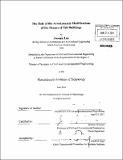The role of the aerodynamic modifications of the shapes of tall buildings
Author(s)
Lee, Jooeun, S.M. Massachusetts Institute of Technology
DownloadFull printable version (19.35Mb)
Other Contributors
Massachusetts Institute of Technology. Dept. of Civil and Environmental Engineering.
Advisor
Jerome J. Connor.
Terms of use
Metadata
Show full item recordAbstract
With the advances in technology, recent tall building design has undergone a shift to the free-style geometric forms in the exuberant and liberal atmosphere. As a height of the building increases, it is more susceptible to vibration caused by wind because of its asymmetric distribution of mass and stiffness, increased flexibility and insufficient inherent damping. This wind-induced motion, in particular crosswind response, endangers the dynamic response of tall structures, the performance of cladding and window, and the habitability of occupants. Therefore, much research on mitigating wind induced excitations of tall buildings has been carried out. This thesis focuses on the effect of shape modification on the wind flow pattern around tall buildings. An appropriate choice of this architectural modification can significantly reduce aeroelastic instabilities. Four aerodynamic modifications to reduce wind-induced responses of a tall building, such as a basic square model, a corner recession model, a 3- step setback model, and a 180 degree helical model, are evaluated through commercial CFD (Computational Fluid Dynamics) software, STAR-CD and compared with results from wind tunnel tests. Based on this comparison, the optimal model to effectively mitigate adverse wind excitations is recommended.
Description
Thesis (S.M.)--Massachusetts Institute of Technology, Dept. of Civil and Environmental Engineering, 2011. Cataloged from PDF version of thesis. Includes bibliographical references.
Date issued
2011Department
Massachusetts Institute of Technology. Department of Civil and Environmental EngineeringPublisher
Massachusetts Institute of Technology
Keywords
Civil and Environmental Engineering.